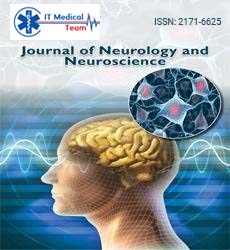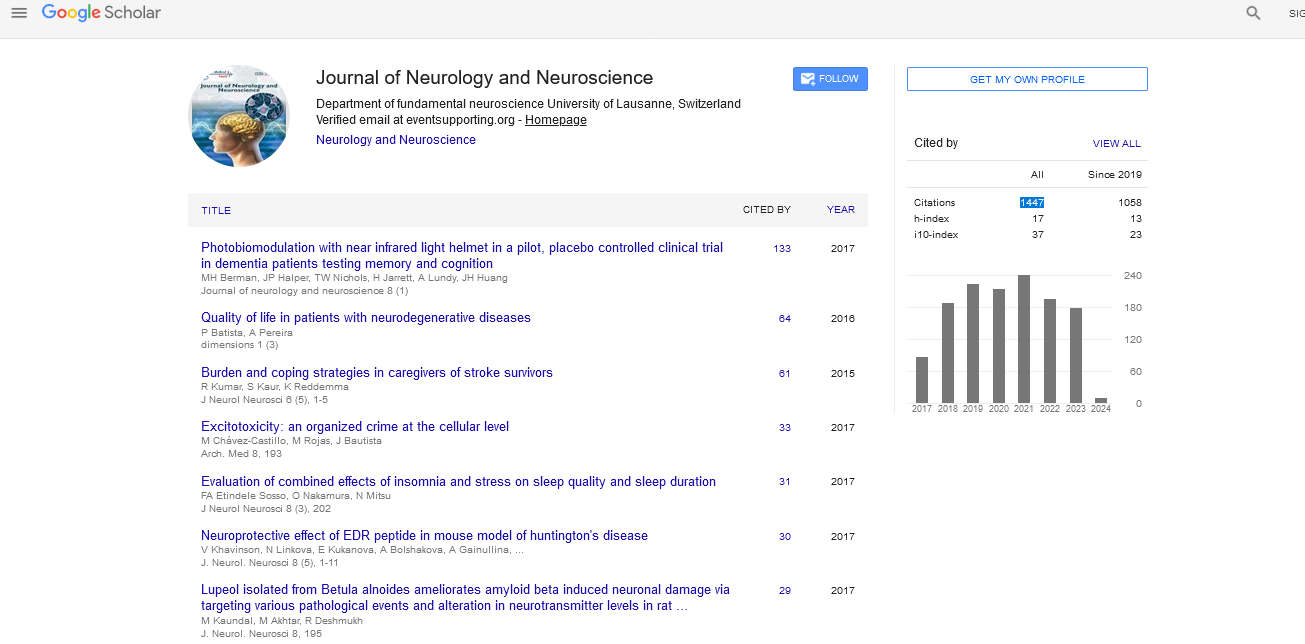Brief Report - (2024) Volume 15, Issue 6
Adenosine pathway changes in schizophrenia: Understanding their effect on frontal cortical neurons
Lemnim Anouk**
Department of Neurosciences & Psychiatry, University of Toledo College of Medicine and Life Sciences, Toledo, United States
*Correspondence:
Lemnim Anouk*, Department of Neurosciences & Psychiatry, University of Toledo College of Medicine and Life Sciences, Toledo,
United States,
Email:
Received: 27-Nov-2024, Manuscript No. ipjnn-25-15497;
Editor assigned: 29-Nov-2024, Pre QC No. P- 15497;
Reviewed: 13-Dec-2024, QC No. Q-15497;
Revised: 18-Dec-2024, Manuscript No. R-15497;
Published:
25-Dec-2024
Abstract
Schizophrenia is a complex neuropsychiatric disorder characterized by cognitive deficits, hallucinations, delusions, and a range of other symptoms that profoundly affect an individual’s ability to function in daily life. While the etiology of schizophrenia is not fully understood, significant advances have been made in understanding its neurobiological basis. One of the emerging areas of research involves the role of adenosine metabolism and its effect on neuronal function, particularly in the frontal cortex, which plays a crucial role in executive functions like decision-making, attention, and working memory. Dysregulation of adenosine signaling has been implicated in schizophrenia, influencing the activity and connectivity of frontal cortical neurons and contributing to the cognitive and behavioral abnormalities associated with the disorder. This article explores the adenosine metabolism pathway and how its changes can impact the functioning of frontal cortical neurons in schizophrenia. By examining the mechanisms involved, we can better understand the potential role of adenosine in the pathophysiology of schizophrenia and its therapeutic implications
INTRODUCTION
Schizophrenia is a complex neuropsychiatric disorder characterized by cognitive deficits, hallucinations, delusions, and a range of other symptoms that profoundly affect an individual’s ability to function in daily life. While the etiology of schizophrenia is not fully understood, significant advances have been made in understanding its neurobiological basis. One of the emerging areas of research involves the role of adenosine metabolism and its effect on neuronal function, particularly in the frontal cortex, which plays a crucial role in executive functions like decision-making, attention, and working memory. Dysregulation of adenosine signaling has been implicated in schizophrenia, influencing the activity and connectivity of frontal cortical neurons and contributing to the cognitive and behavioral abnormalities associated with the disorder. This article explores the adenosine metabolism pathway and how its changes can impact the functioning of frontal cortical neurons in schizophrenia. By examining the mechanisms involved, we can better understand the potential role of adenosine in the pathophysiology of schizophrenia and its therapeutic implications [1].
DESCRIPTION
Adenosine is a purine nucleoside that plays a key role in numerous physiological processes, including cellular energy regulation, neurotransmission, and the modulation of inflammation. In the brain, adenosine primarily functions as a neuromodulator, influencing the activity of neurotransmitter systems like dopamine, glutamate, and GABA (gammaaminobutyric acid). It exerts its effects through the activation of specific receptors, primarily A1 and A2A receptors, which are found throughout the central nervous system, including in the frontal cortex. Adenosine is produced in the brain as a result of the breakdown of ATP (adenosine triphosphate) during cellular metabolism. The production of adenosine is tightly regulated by enzymes such as adenosine deaminase and ecto-5'-nucleotidase. Once released, adenosine interacts with its receptors, modulating neuronal excitability and synaptic transmission. In particular, adenosine has inhibitory effects on neurotransmitter release, promoting a balance in brain activity that is essential for normal cognitive function. In the context of schizophrenia, disturbances in adenosine signaling can lead to altered neuronal activity, particularly in the frontal cortex, which has been shown to be affected in terms of both structure and function in patients with schizophrenia. The balance between excitatory and inhibitory signals in the brain is crucial for cognitive processes like working memory, attention, and executive function, which are often impaired in schizophrenia. [2]. The frontal cortex is one of the brain regions most commonly associated with cognitive impairments in schizophrenia. This region is responsible for high-level cognitive functions, 2 − 15 (06) 2022: 001-002 © J Neurol Neurosci 1. Sullivan CR, O’Donovan SM, McCullumsmith RE, et al. Defects in bioenergetic coupling in schizophrenia. Biol Psychiatry. 2018; 83(9):739- 750. 2. Uno Y, Coyle JT. Glutamate hypothesis in schizophrenia. Psychiatry Clin Neurosci. 2019; 73(5):204-215. 3. Malewska-Kasprzak MK, Permoda-Osip A, Rybakowski J. Disturbances of purinergic system in affective disorders and schizophrenia. Psychiatr Pol 2019 30; 53(3):577-87. 4. Yee BK, Singer P, Chen JF, et al. Transgenic overexpression of adenosine kinase in brain leads to multiple learning impairments and altered sensitivity to psychomimetic drugs. Eur J Neurosci. 2007 Dec; 26(11):3237-52. 5. Moody CL, Funk AJ, Devine E, et al. Adenosine kinase expression in the frontal cortex in schizophrenia. Schizophr Bull. 2020; 46(3):690-8. including executive control, decision-making, and social cognition. In schizophrenia, the frontal cortex is frequently observed to exhibit structural abnormalities, such as reduced gray matter volume, and functional deficits, such as impaired activation during cognitive tasks. Adenosine plays a significant role in modulating neuronal activity within the frontal cortex. Its effects on neuronal firing patterns, synaptic plasticity, and neurotransmitter release are essential for maintaining proper cognitive function. For example, the activation of A1 receptors by adenosine generally inhibits neuronal firing, helping to regulate excitatory neurotransmission. Conversely, A2A receptors, which are more prevalent in the basal ganglia but also found in the frontal cortex, promote the release of certain neurotransmitters, such as dopamine. This dual role of adenosine in modulating excitatory and inhibitory signals is crucial for the balance of brain activity and the regulation of cognitive functions [3]. Adenosine metabolism is also regulated by enzymes such as adenosine deaminase and ecto-5'-nucleotidase, which modulate the production and degradation of adenosine. In schizophrenia, these enzymes may be dysregulated, leading to an imbalance in adenosine levels. For example, increased adenosine degradation could result in a reduction in extracellular adenosine concentrations, potentially impairing its ability to activate A1 receptors and maintain proper neuronal inhibition. Conversely, reduced adenosine degradation could lead to excessive adenosine signaling, particularly at A2A receptors, which could have detrimental effects on dopamine regulation and other neurotransmitter systems involved in schizophrenia. The changes in adenosine signaling described above likely have significant implications for cognitive function in schizophrenia. The frontal cortex, which is heavily involved in cognitive processes such as working memory, decision-making, and inhibitory control, relies on a delicate balance of excitatory and inhibitory signals to maintain optimal function. Dysregulation of this balance due to altered adenosine signaling can impair these cognitive functions, which are commonly affected in individuals with schizophrenia. For example, a reduction in A1 receptor function in the prefrontal cortex could lead to neuronal hyperactivity, which may impair working memory and attention. On the other hand, an upregulation of A2A receptor signaling could contribute to excessive dopaminergic activity, which has been linked to cognitive deficits in schizophrenia, such as difficulties with goal-directed behavior and the processing of complex stimuli [4]. Understanding the role of adenosine metabolism and its effects on frontal cortical neurons in schizophrenia opens up new avenues for potential therapeutic interventions. Modulating the adenosine pathway may offer a novel approach to addressing the cognitive and neurochemical abnormalities observed in schizophrenia. For instance, the use of adenosine receptor agonists or antagonists could help restore the balance of neurotransmitter signaling, improving both cognitive and positive symptoms. Additionally, targeting specific enzymes involved in adenosine metabolism could help regulate adenosine levels in a more controlled manner, potentially reducing neuronal hyperactivity or enhancing inhibitory control in the frontal cortex. However, further research is needed to fully understand the therapeutic potential of modulating the adenosine pathway in schizophrenia, as the effects of adenosine signaling are complex and context-dependent.
CONCLUSION
Adenosine metabolism and signaling play a crucial role in maintaining the balance of excitatory and inhibitory neurotransmission in the brain. In schizophrenia, alterations in the adenosine pathway can disrupt this balance, particularly in the frontal cortex, leading to cognitive impairments and other symptoms associated with the disorder. Understanding the mechanisms by which adenosine influences neuronal activity and dopaminergic signaling in schizophrenia is essential for developing new therapeutic strategies. By targeting the adenosine pathway, it may be possible to address the underlying neurochemical and cognitive dysfunctions in schizophrenia, offering hope for improved treatments for individuals affected by this debilitating disorder.
REFERENCES
<ol>
<li><a name="1" id="1"></a><strong>Sullivan CR, O’Donovan SM, McCullumsmith RE, et al.</strong> <a href="https://www.sciencedirect.com/science/article/pii/S0006322317320991" target="_blank">Defects in bioenergetic coupling in schizophrenia</a>. <em>Biol Psychiatry</em>. 2018; 83(9):739-750.</li>
<p align="right"><a href="https://scholar.google.com/scholar_lookup?title=Defects+in+Bioenergetic+Coupling+in+Schizophrenia&author=Sullivan,+C.R.&author=O%E2%80%99Donovan,+S.M.&author=McCullumsmith,+R.E.&author=Ramsey,+A.&publication_year=2018&journal=Biol.+Psychiatry&volume=83&pages=739%E2%80%93750&doi=10.1016/j.biopsych.2017.10.014&pmid=29217297" target="_blank"><u>Google Scholar</u></a>, <a href="https://doi.org/10.1016/j.biopsych.2017.10.014" target="_blank"><u>Crossref</u></a>, <a href="https://www.ncbi.nlm.nih.gov/pubmed/29217297" target="_blank"><u>Indexed at</u></a></p>
<li><a name="2" id="2"></a><strong>Uno Y, Coyle JT.</strong> <a href="https://onlinelibrary.wiley.com/doi/abs/10.1111/pcn.12823" target="_blank">Glutamate hypothesis in schizophrenia</a>. <em>Psychiatry Clin Neurosci</em>. 2019; 73(5):204-215.</li>
<p align="right"><a href="https://scholar.google.com/scholar_lookup?title=Glutamate+hypothesis+in+schizophrenia&author=Uno,+Y.&author=Coyle,+J.T.&publication_year=2019&journal=Psychiatry+Clin.+Neurosci.&volume=73&pages=204%E2%80%93215&doi=10.1111/pcn.12823&pmid=30666759" target="_blank"><u>Google Scholar</u></a>, <a href="https://doi.org/10.1111/pcn.12823" target="_blank"><u>Crossref</u></a>, <a href="https://www.ncbi.nlm.nih.gov/pubmed/30666759" target="_blank"><u>Indexed at</u></a></p>
</ol>





